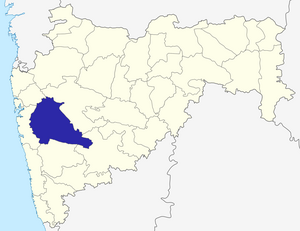Pune (district)
| Pune District | |
|---|---|

|
|
| State | Maharashtra |
| Division : | Pune |
| Administrative headquarters : | Pune |
| Area : | 15,642 km² |
| Residents : | 9,426,959 (2011) |
| Population density : | 600 people / km² |
| Website : | pune.nic.in |

The district of Pune is located in the state of Maharashtra in south-west India .
The city of the same name, Pune, is the capital of the district. The last census in 2011 showed a total population of 9,426,959 people. This makes Pune the fourth most populous district in India (640 in total).
history
From pre-Christian times to the year 1318 the area - like the whole region - was ruled by various Buddhist and Hindu rulers. The first state known by name was the Maurya Empire , the last non-Muslim dynasty were the Yadavas of Devagiri. After decades of military clashes with Muslim rulers in northern India, it was occupied by Muslim soldiers in 1318. Thereafter, various Muslim dynasties ruled until 1714 (Sultanate of Delhi, Bahmani, Dekkan sultanates and the Great Mughals). In 1714 the area became part of the Hindu Marathi Empire. After the defeat of the Marathas against the British, it came to the British Empire, more precisely to the British administrative region Bombay Presidency . With India's independence in 1947 and the reorganization of the country, it became part of the new state of Bombay in 1950 . In 1960, Bombay State was divided and the area came to the newly created state of Maharashtra.
population
Population development
As everywhere in India, the population in the Pune district has been growing rapidly for decades. The increase in the years 2001–2011 was over 30 percent (30.37%). In those ten years the population increased by nearly 2.2 million people. The following table shows the exact numbers:

Significant places
The most populous town in the district is the capital Pune with more than 3.1 million inhabitants. Another metropolis is Pimpri-Chinchwad . Other important cities with over 50,000 inhabitants are Kirkee (Cantonment) , Pune (Cantonment) , Lonavla , Talegaon Dabhade and Baramati . The urban population makes up 58.08% of the absolute population.

Population of the district by confession
A clear vast majority of the population are Hindus. The Muslims and Buddhists form smaller minorities. The following table shows the exact religious composition of the population:
| year | Buddhists | Christians | Hindus | Jainas | Muslims | Sikhs | Others 1 | not specified | Total | |||||||||
|---|---|---|---|---|---|---|---|---|---|---|---|---|---|---|---|---|---|---|
| number | % | number | % | number | % | number | % | number | % | number | % | number | % | number | % | Residents | % | |
| 2001 | 321,948 | 4.45% | 116,661 | 1.61% | 6,197,349 | 85.69% | 104,073 | 1.44% | 452.397 | 6.26% | 21,938 | 0.30% | 11,283 | 0.16% | 6,906 | 0.10% | 7,232,555 | 100.00% |
| Source: 2001 India Census | ||||||||||||||||||
1 including 4,196 parsing
District population by language
A clear vast majority of around 80 percent of the population speaks Marathi. Significant linguistic minorities with more than 100,000 native speakers are Hindi (around 690,000 people with Hindi dialects), Urdu, Kannada and Telugu. Marwari (Hindi dialect with Marathi influences), Gujarati, Malayalam (47,912), Tamil (47,504), Sindhi (40,602), Vadari (a Telugu dialect; 35,282), Lamani / Lambadi (Hindi dialect; 30,604), Panjabi (28,500), Bengali (22,628) and Konkani (19,594) are spoken by over 10,000 people each. The following table shows the exact linguistic composition of the population:
| year | Marathi | Hindi | Urdu | Kannada | Telugu | Marwari | Gujarati | Other | Total | |||||||||
|---|---|---|---|---|---|---|---|---|---|---|---|---|---|---|---|---|---|---|
| number | % | number | % | number | % | number | % | number | % | number | % | number | % | number | % | Residents | % | |
| 2001 | 5,742,291 | 79.40% | 520.089 | 7.19% | 170,658 | 2.36% | 118,648 | 1.64% | 118.257 | 1.64% | 99,850 | 1.38% | 82,487 | 1.14% | 380.275 | 5.26% | 7,232,555 | 100.00% |
| Source: 2001 India Census | ||||||||||||||||||
See also
Web links
- District website
- [1] - Map of the Pune District
- [2] - Pune District
- [3] - Economy, nature and sights
